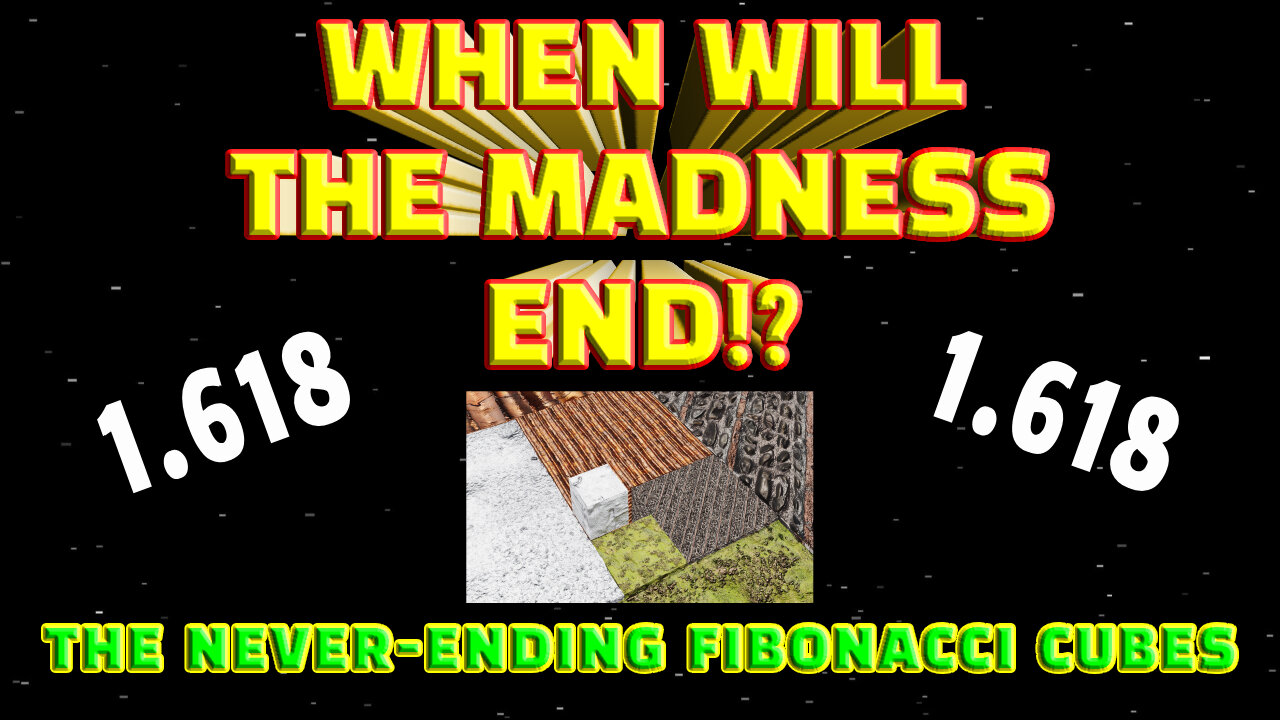Premium Only Content

When Will The Madness End!? - The Never-Ending Fibonacci Cubes
Watch as these magic cubes keep partially filling this hole, but do not seem to ever fully fill it. The pattern just keeps going on and on and on and on. When will it finally fill the hole? When will the madness end?!
This was a fun but tedious Blender project that I've bene working on for quite some time. It uses the "Fibonacci Sequence" or "The Golden Rule", where size of each cube is dictated by the two preceding ones ( ex - 0,1,1,2,3,5,8,13,21,34, etc ). "The Golden Ratio" numbers is basically 1.618. Making this video, I was able to learn more about Fibonacci and 'procedural materials' in Blender, done the correct way. The materials I used in this video are "clay roof tiles", "patterned brick", "rocket terrain" and "snow", which assets I downloaded from Polyhaven.com.
The original creator of this idea is "Jake Fellman", whom you can find on Youtube. And thanks goes out to "CG Geek" of Youtube for his extensive Blender tutorial on how to duplicate Jake's Blender project.
Music a creation of my own, "Endless Cubes", using MusicHero.ai.
More "Argyle302 Animations": https://rumble.com/c/Animations
This video was created in February 2025, and completed on February 19th, 2025, using Blender 4.3.2, and CapCut 4.6.0 ( 30,000 Kbps ).
If you enjoyed watching this video, please remember to "SMASH" that like button, and leave a comment if you desire to do so. And don't forget to subscribe to my channel, so you won't miss any future animation content, and more. It all only takes seconds to do. Thanks for watching and have a nice day!
Wikipedia: Fibonacci Sequence
In mathematics, the Fibonacci sequence is a sequence in which each element is the sum of the two elements that precede it. Numbers that are part of the Fibonacci sequence are known as Fibonacci numbers, commonly denoted Fn . Many writers begin the sequence with 0 and 1, although some authors start it from 1 and 1 and some (as did Fibonacci) from 1 and 2. Starting from 0 and 1, the sequence begins
0, 1, 1, 2, 3, 5, 8, 13, 21, 34, 55, 89, 144, ... (sequence A000045 in the OEIS)
A tiling with squares whose side lengths are successive Fibonacci numbers: 1, 1, 2, 3, 5, 8, 13 and 21, The Fibonacci numbers were first described in Indian mathematics as early as 200 BC in work by Pingala on enumerating possible patterns of Sanskrit poetry formed from syllables of two lengths. They are named after the Italian mathematician Leonardo of Pisa, also known as Fibonacci, who introduced the sequence to Western European mathematics in his 1202 book Liber Abaci.
Fibonacci numbers appear unexpectedly often in mathematics, so much so that there is an entire journal dedicated to their study, the Fibonacci Quarterly. Applications of Fibonacci numbers include computer algorithms such as the Fibonacci search technique and the Fibonacci heap data structure, and graphs called Fibonacci cubes used for interconnecting parallel and distributed systems. They also appear in biological settings, such as branching in trees, the arrangement of leaves on a stem, the fruit sprouts of a pineapple, the flowering of an artichoke, and the arrangement of a pine cone's bracts, though they do not occur in all species.
Fibonacci numbers are also strongly related to the golden ratio: Binet's formula expresses the n-th Fibonacci number in terms of n and the golden ratio, and implies that the ratio of two consecutive Fibonacci numbers tends to the golden ratio as n increases. Fibonacci numbers are also closely related to Lucas numbers, which obey the same recurrence relation and with the Fibonacci numbers form a complementary pair of Lucas sequences.
-
 LIVE
LIVE
SynthTrax & DJ Cheezus Livestreams
4 days agoLumines - Arise - DJ Cheezus Birthday Stream
70 watching -
 1:00:41
1:00:41
Glenn Greenwald
5 hours agoEXCLUSIVE: Succession Actress & Podcast Host Dasha Nekrasova Speaks Out About Hollywood Cancellation Over Fuentes Interview | SYSTEM UPDATE #549
86.8K49 -
 LIVE
LIVE
ThisIsDeLaCruz
49 minutes agoRunning Sound for Linkin Park
257 watching -
 31:27
31:27
Robbi On The Record
6 hours agoAstrology VS God: The Conversation Culture Has Been Avoiding | ft. JT Follows JC
1172 -
 LIVE
LIVE
SOLTEKGG
23 minutes ago🟢 Live: Pro Player Returns to Battlefield 6 RED SEC
34 watching -
![Gray Zone Warfare [RGMT CONTENT Mgr. | RGMT GL | GZW CL]](https://1a-1791.com/video/fww1/bd/s8/1/m/O/L/B/mOLBz.0kob-small-Gray-Zone-Warfare-RGMT-CONT.jpg) LIVE
LIVE
XDDX_HiTower
13 minutes agoGray Zone Warfare [RGMT CONTENT Mgr. | RGMT GL | GZW CL]
13 watching -
 1:06:20
1:06:20
BonginoReport
4 hours agoTrump, Vance “SNUBBED” by Never-Trumper Cheneys - Nightly Scroll w/ Hayley Caronia (Ep.182)
56.2K28 -
 LIVE
LIVE
StevieTLIVE
1 hour ago#1 Warzone Sniper POV 6.9 KD
21 watching -
 LIVE
LIVE
Reolock
2 hours agoGO EVEN FURTHER BEYOND! - Rumble Rebellion Speedruns
18 watching -
 58:40
58:40
Donald Trump Jr.
4 hours agoCan California be Golden Again? Interview with Gubernatorial Candidate Steve Hilton | TRIGGERED Ep.293
84.3K59